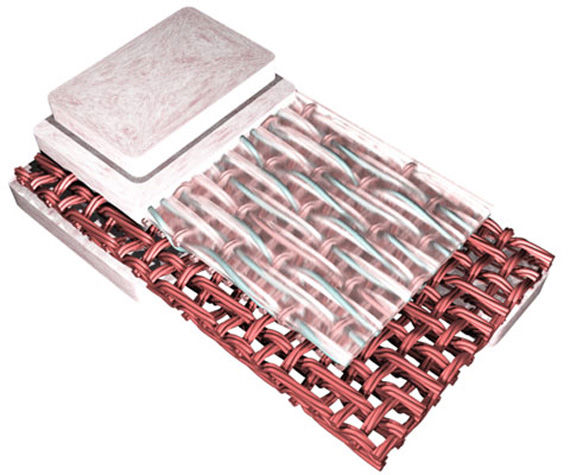Valmet Press Felt SPM, a next-generation press felt for demanding machine conditions

Valmet Press Felt SPM's optimized base fabric consists of two woven bases with a special sublayer on the paper side.
Designed for high-speed printing and packaging paper machines, Valmet Press Felt SPM (earlier known as SprintMaster) has a structure that provides a good start-up and high nip dewatering similar to that of nonwoven or hybrid felts, but without the need for any special chemical start-up treatment. It also features strength and stability as good as conventional woven laminated felts. Coming in a variety of base weights, the felt can be used in all positions. The best results have been achieved on high-speed printing paper machines in PU positions where the usage of nonwoven or hybrid felts is often limited due to the risk of felt plugging and/or edge-related problems or low cross machine directional (CMD) stability of the felt. “The felts have been tested, proven and chosen as standard products on many demanding SC, newsprint and fine paper machines. The first trials on packaging machines have been successful, too,” says Leena Silakoski, Product Manager for press felts at Valmet.
Optimized nip dewatering
By optimizing and maximizing nip dewatering, it is possible to reach high dryness and a good felt cleaning effect in the nip. In a conventional press section, the draw level has been reduced through increased dewatering in the first nips. This allows higher machine speeds with the same or better paper properties, such as higher elongation and low porosity.
The dewatering speed through the felt in the Z direction in the nip is key to maximized dewatering in the nip.

When the base has an open structure, the Z direction dewatering speed is low and the felt carries water to the Uhle boxes. This also means lower hydraulic pressure due to lower saturation and flow resistance. Rewetting after the felt/sheet separation point is higher, too.

Optimized dewatering in the first and second nips provides a base for good runnability. For example, maximum nip dewatering downwards in the first nip gives a low draw level because the bottom side of the sheet is drier. Good dewatering in the first nip and the optimum water content in the felt reduce edge-related problems, too. The felt designs and nip performance can be optimized either by changing both felt positions (PU and the first press) to denser and/or lighter felts, or by changing only one of them. Even one felt change increases hydraulic pressure and improves dewatering on both sides.
A unique base structure
“Valmet Press Felt SPM has a unique structure, with a base fabric consisting of two woven bases with a special sublayer on the paper side. This optimizes water removal and start-up, maintains high felt strength and extends its lifetime,” Silakoski explains.
The absorbent sublayer densifies the felt structure in the middle, enabling the felt to immediately reach high saturation and stay saturated throughout its lifetime. Hydraulic pressure increases in the nip, resulting in a fast start-up and excellent nip dewatering.
According to Silakoski, rewetting is minimal. High hydraulic pressure pushes water through the felt quickly, and the special sublayer element blocks the water inside the felt so that the surface of the felt does not get too wet.
The base structure does not burst like nonwoven or hybrid felts sometimes do, even under high wear. The woven base structure and high CMD yarn density give very good CMD stability.
The base structure of Valmet Press Felt SPM offers an optional base for batt fiber needling. The fibers are interlocked well with the special laminated base as a result of good fiber adhesion. “Good fiber entanglement can be seen in used felt analyses: In most cases, Valmet Press Felt SPM suffer less wear than conventional laminated or special hybrid designs,” explains Juha Korvenniemi, Business Development Manager for PMC at Valmet. “Of course, the reduced wear is partly due to increased nip dewatering and reduced vacuum levels on some of the machines.”
Large savings potential
The benefits of the Valmet Press Felt SPM include a very good start-up, high nip dewatering, stability and durability. “They provide the mill with a large savings potential thanks to improvements in runnability, dry content, start-up and felt lifetime and energy consumption,” Korvenniemi concludes.
Three Valmet Press Felt SPM high-speed machinesCase 1 Press section: conventional 3 nips + 4th press/paper grade: SC/PU press felt: Valmet Press Felt SPM
Case 2 Press section: conventional 3 nips and a 4th press/paper grade: newsprint/PU press felt: Valmet Press Felt SPM
Case 3 Press section: conventional 3 nips/paper grade: testliner/first press felt: Valmet Press Felt SPM
|
Article originally published in Forward customer magazine 1/2015